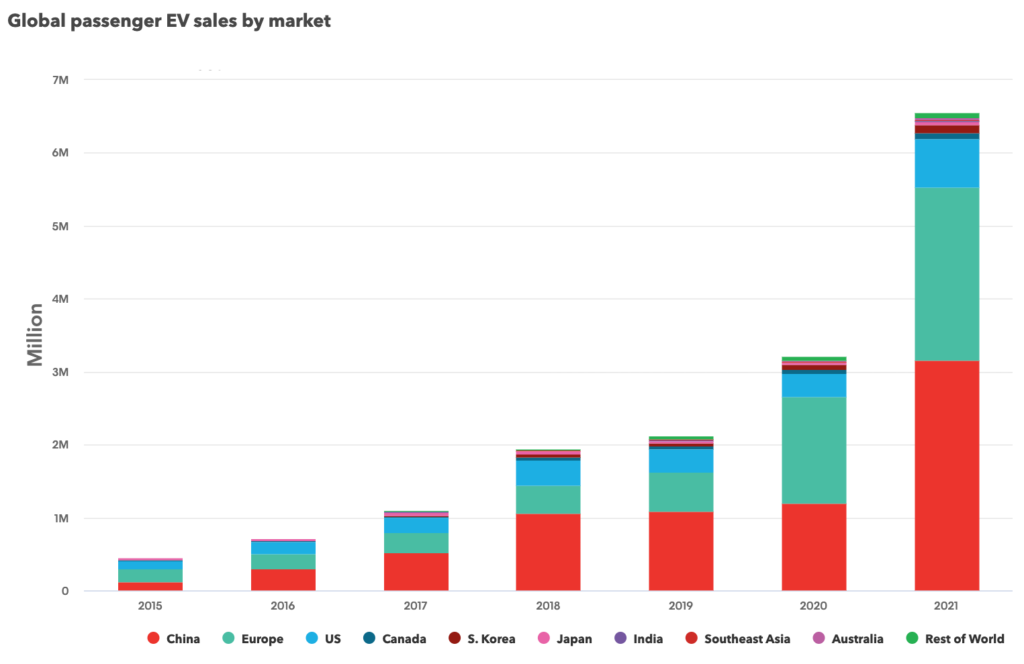The document outlines two scenarios for the uptake of electric transport to 2050 and examines impacts on demand for batteries, materials, oil, electricity, infrastructure and emissions. The Economic Transition Scenario (ETS), which assumes no new policies and regulations are enacted, is primarily driven by techno-economic trends and market forces. The second scenario investigates what a potential route to net-zero emissions looks like for the road transport sector by 2050. This Net Zero Scenario (NZS) looks primarily at economics as the deciding factor for which drivetrain technologies are implemented to hit the 2050 target.
Passenger electric vehicle sales are set to rise from 6.6 million sold in 2021 to 21 million in 2025. The fleet of EVs on the road hits 77 million by 2025 and 229 million by 2030, based on BNEF’s Economic Transition Scenario. That’s up from 16 million at the end of 2021, and reflective of the remarkable success story of EVs in the energy transition to date.

Meanwhile, the market researcher found that sales of internal combustion engine vehicles already peaked in 2017 and, thus, the expectation is that the global fleet of ICE passenger vehicles will start to decline in 2024.
According to BNEF, to get on track for a net-zero global fleet by 2050, zero-emission vehicles need to represent 61% of global new passenger vehicle sales by 2030, 93% by 2035, and the last ICE vehicle of any segment needs to be sold by 2038.
In the view of the report’s lead author Colin McKerracher, developed countries and multilateral institutions should include electric vehicle investments, incentives and charging infrastructure deployments in their international climate finance plans, making capital available to emerging economies that have credible plans to develop this sector. Since concessional finance has been a key enabler for the development of renewable power generation in emerging economies, it could play a similar role in the EV sector.
“The fleet of passenger electric vehicles is set to hit 469 million in 2035 in the Economic Transition Scenario but needs to jump to 612 million by the same date in the Net Zero Scenario,” the dossier reads. “Much of the gap will have to be met in emerging economies, while wealthy countries should look at ways to support the transition in those markets and avoid a global slowdown of adoption.”
Heavy duty
The report notes that two- and three-wheelers and buses are already very close to the trajectory needed to achieve BNEF’s NZS. However, medium and heavy commercial vehicles are lagging far behind, and need strong additional policy measures to meet net-zero.
“Under the Economic Transition Scenario, only 29% of these vehicles achieve zero emissions by 2050 – far from the full adoption needed for net-zero,” the document points out. “In addition to introducing tighter fuel economy or CO2 standards for trucks, governments may need to consider mandates for the electrification of fleets, including those of governments and transport operators. Governments should also consider zero-emissions zones in cities, and incentives to push freight into smaller trucks which can electrify faster than larger ones.”
For the experts at BNEF, battery-electric trucks are likely to become a viable option for heavy-duty long-haul operations by the end of the 2020s, when megawatt-scale charging stations and higher energy density batteries become a reality.
“Direct electrification via batteries appears to be the most economically attractive and efficient approach to decarbonizing road transport, including trucking, and should be pursued wherever possible,” the report states. “Hydrogen fuel cell vehicles can help fill the small gaps left by electrification in some heavy vehicles, in regions or duty cycles where batteries struggle.”




